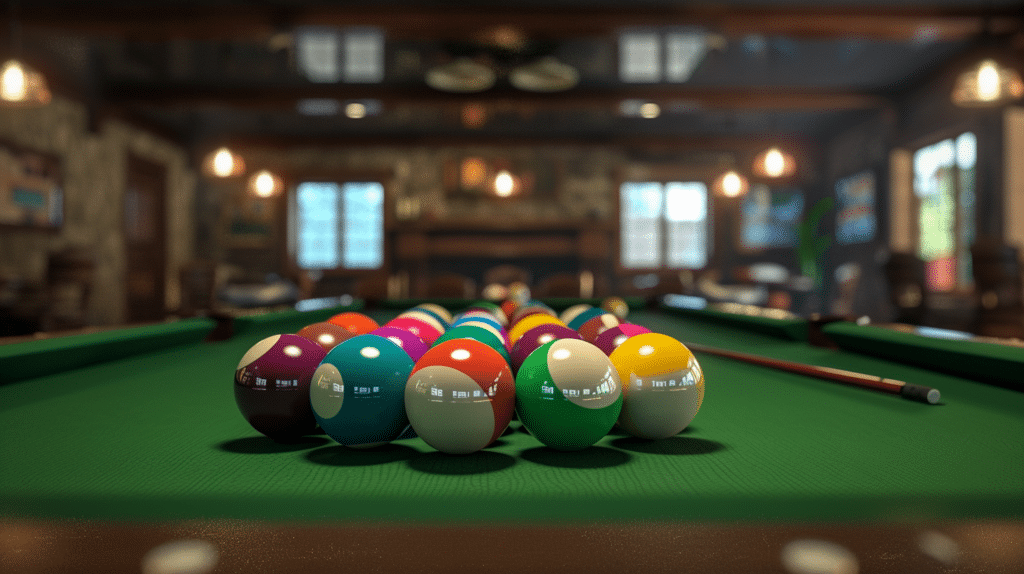Pool, also known as pocket billiards, is a popular cue sport enjoyed by millions worldwide. Whether you’re a beginner or an experienced player looking to refine your skills, mastering the fundamentals of pool can enhance your gameplay and elevate your enjoyment of the game. In this comprehensive guide, we’ll delve into the rules, techniques, strategies, and etiquette of playing pool, providing you with the knowledge to become a proficient player.
Table of Contents
ToggleUnderstanding the Basics
Before diving into gameplay, it’s essential to familiarize yourself with the basic components of the game:
- The Table: Pool is typically played on a rectangular table covered with felt and surrounded by cushions. The table’s surface consists of six pockets, one at each corner and one in the middle of each long side.
- Balls: A standard pool set comprises 16 balls, including one cue ball (usually white) and 15 object balls. The object balls are divided into two groups: solid-colored balls numbered 1 through 7 (often referred to as “solids” or “low balls”) and striped balls numbered 9 through 15 (known as “stripes” or “high balls”). The 8-ball is black and serves as the game-winning ball.
- Cue Stick: The cue stick is the primary tool used to strike the cue ball. It consists of a tapered shaft with a tip at one end and a grip or butt at the other end.
Gameplay and Rules
Pool can be played in various formats, but the most common versions include 8-ball and 9-ball. Here’s a brief overview of each:
- 8-Ball: In 8-ball, players are divided into two groups, with one group aiming to pocket all the solid balls (1 through 7) and the other group targeting the striped balls (9 through 15). The player or team that pockets their designated group’s balls must then pocket the 8-ball to win the game.
- 9-Ball: In 9-ball, players must pocket the balls in numerical order, starting with the 1-ball and ending with the 9-ball. Unlike 8-ball, where players have the option to choose their group of balls, 9-ball follows a sequential order.
Basic Techniques and Stance
To excel at pool, mastering basic techniques and adopting the correct stance are crucial. Here are some essential tips:
- Grip: Hold the cue stick with a relaxed grip, ensuring your fingers wrap comfortably around the butt of the cue. Avoid gripping the cue too tightly, as this can impede your stroke.
- Stance: Stand with your feet shoulder-width apart and your body perpendicular to the cue ball. Position your dominant foot forward and your non-dominant foot slightly back for stability. Bend your knees slightly and maintain a balanced posture throughout your shot.
- Bridge: Create a stable bridge by resting your non-dominant hand (bridge hand) on the table and forming a V-shape with your thumb and index finger. Place the cue stick within the bridge, ensuring a smooth and controlled stroke.
- Cueing: Position the cue tip slightly below the center of the cue ball for most shots. Keep your cueing arm parallel to the table and your elbow slightly bent. Maintain a fluid and straight stroke, avoiding jerky movements.
Advanced Techniques and Strategies
As you gain proficiency in the game, you can incorporate advanced techniques and strategies to enhance your gameplay:
- English or Spin: Apply sidespin to the cue ball by striking it off-center. English allows you to control the trajectory and spin of the cue ball, enabling you to execute precise shots such as banks and caroms.
- Position Play: Plan ahead and strategize your shots to position the cue ball for the next shot. Consider the angles, speed, and spin required to navigate around obstacles and pocket the desired balls.
- Safety Shots: Sometimes, the best strategy is to play defensively by executing safety shots. These shots involve positioning the cue ball in a manner that makes it challenging for your opponent to execute their next shot effectively.
Etiquette and Sportsmanship
In addition to mastering the technical aspects of the game, practicing good sportsmanship and adhering to proper etiquette are essential aspects of playing pool:
- Respect Your Opponent: Treat your opponent with courtesy and respect, regardless of the outcome of the game. Avoid engaging in unsportsmanlike behavior or distracting your opponent during their turn.
- Be Mindful of Others: Maintain a quiet and focused atmosphere when others are playing nearby. Refrain from excessive noise or movements that may disrupt other players’ concentration.
- Rack and Break: Ensure that the balls are properly racked before each game, and break the rack with controlled force to avoid damaging the table or equipment.
Advanced Strategies and Techniques
As you progress in your pool-playing journey, mastering advanced strategies and techniques can significantly elevate your gameplay and give you a competitive edge. Here are some advanced strategies and techniques to consider incorporating into your pool game:
- Pattern Play: Develop the ability to recognize and execute pattern plays, which involve planning several shots in advance to clear the table efficiently. By visualizing the layout of balls on the table and anticipating the cue ball’s trajectory after each shot, you can strategically maneuver your way through complex patterns and run racks with precision.
- Cue Ball Control: Mastery of cue ball control is essential for executing advanced shots and positioning the cue ball for optimal position on subsequent shots. Experiment with various cue ball paths, speeds, and spins to navigate around clusters of balls, avoid scratches, and set up your next shot with precision.
- Bank Shots and Kicks: Expand your repertoire of shots by mastering bank shots and kicks. Bank shots involve striking the cue ball off a cushion to pocket a ball, while kicks involve hitting an object ball indirectly using one or more cushions. Understanding the principles of angle of incidence and angle of reflection is crucial for executing successful bank shots and kicks consistently.
- Jump Shots: Learn the art of jump shots, which involve elevating the cue stick and cue ball to clear obstructing balls and pocket a desired ball. Utilize specialized jump cues and practice proper technique to achieve controlled jumps and execute shots with accuracy. However, exercise caution when attempting jump shots, as they carry a risk of scratching or fouling if not executed correctly.
- Break Control: Fine-tune your break shot to maximize your chances of pocketing balls and gaining an advantage at the start of each game. Experiment with different break speeds, positions, and techniques, such as the cut break or power break, to achieve optimal cue ball movement and ball dispersion on the break. Additionally, study the layout of the balls after the break to anticipate potential run-out opportunities or safety plays.
- Defensive Play: Develop a strategic mindset that incorporates defensive play when necessary to gain a tactical advantage over your opponent. Use safety shots to strategically position the cue ball in challenging spots or behind clusters of balls, forcing your opponent into difficult or low-percentage shots. Effective defensive play requires careful consideration of cue ball placement and anticipation of your opponent’s potential responses.
- Mental Toughness: Cultivate mental toughness and resilience to maintain focus, composure, and confidence during competitive matches. Practice visualization techniques to mentally rehearse shots and scenarios, visualize successful outcomes, and overcome challenges or setbacks with a positive mindset. By mastering the mental aspects of the game, you can enhance your performance under pressure and make informed decisions with clarity and conviction.
Mastering advanced strategies and techniques in pool requires dedication, practice, and a deep understanding of the game’s nuances. By incorporating these advanced concepts into your gameplay and continually refining your skills, you can elevate your performance to new heights and compete with confidence against formidable opponents. Whether you’re aiming to excel in friendly matches or competitive tournaments, the pursuit of mastery in pool is a rewarding journey that offers endless opportunities for growth, learning, and achievement.






